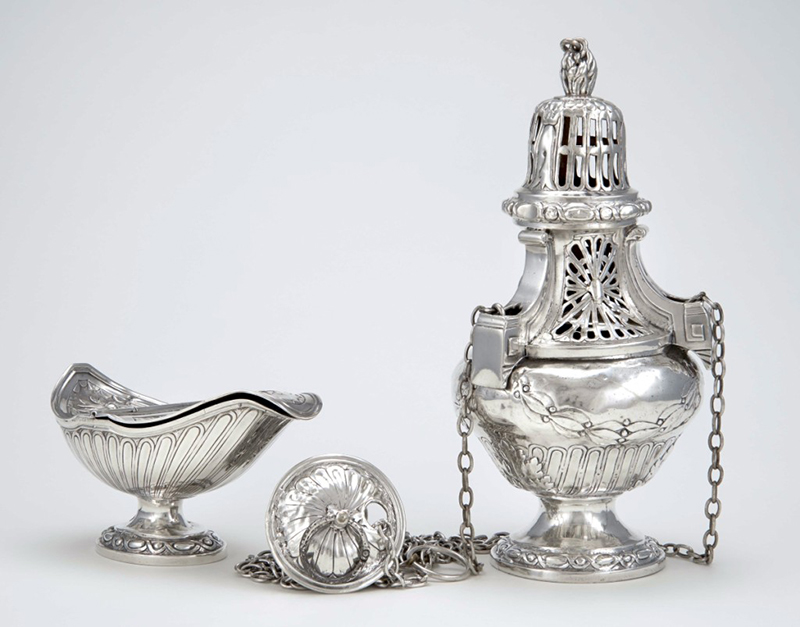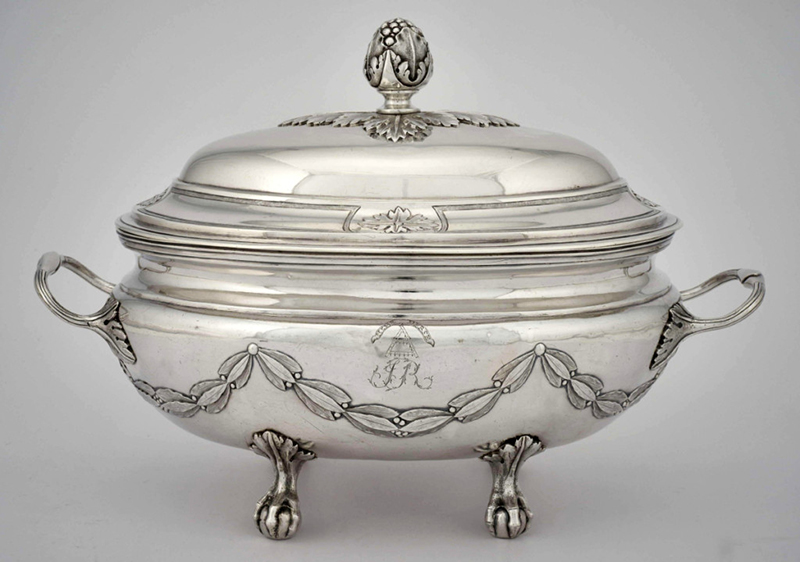
Censer and incense boat of Saint-Anselme, 1837. Silver center with chains. National Gallery of Canada, Ottawa. Purchased 1965 and 1967 (14815; 15322). Photo NGC.
By Laura Beach
OTTAWA – Americans tend to think of antiquarianism as something born in Boston and transplanted to New York in the first decades of the Twentieth Century. But as René Villeneuve, curator of early Canadian art at the National Gallery of Canada (NGC), relates in the splendid new volume Laurent Amiot: Canadian Master Silversmith and the accompanying exhibition of the same name, Canadians, prompted by some of the same influences, were on a parallel mission of their own.
Though not the first to admire the work of the Quebec master Amiot (1764-1839), the Welsh-born scholar E. Alfred Jones – who visited Nova Scotia, New Brunswick, Quebec and New England in preparation for his 1913 book The Old Silver of American Churches – was in the forefront when he published an article on early Canadian silver in 1918. The following year, in memory of Canadian soldiers killed in the Great War, Jones presented an Amiot ladle to London’s Victoria and Albert Museum, the first arts institution to own such a prize. The American collector Francis P. Garvan acquired Jones’s collection of what was described as “Catholic silver from Canada” in 1929, leaving it with Yale University Art Gallery until the group’s 1947 purchase by Henry G. Birks, whose holdings form the foundation of NGC’s Canadian silver collection. In circuitous fashion, Jones’s archives went to Yale, which ultimately, and under some pressure, surrendered to Canada the Quebec material, including a rare set of Amiot drawings.
Villeneuve – the keeper of a large collection of pre-Confederation paintings, sculpture, silver, furniture and textiles made between roughly 1650 and 1870, mostly in French Canada, Ontario and the Maritime Provinces – has been at his post nearly 32 years. He recalls his first, decisive encounter with Amiot silver more than 40 years ago in what he describes as a dark, paneled sacristy. He wrote the pioneering entry for the artist in the Dictionary of Canadian Biography in 1988, and over the past three decades has added 11 more pieces of Amiot silver to the NGC’s collections. He writes, “The research undertaken with each acquisition has confirmed that every one of the works possesses some unique feature that offers rich scholarly potential. The oeuvre of Amiot, who was active in Quebec City between 1787 and 1839, is now an object of study.”
With book and exhibition, Villeneuve hopes to redress what he sees as an imbalance. Notwithstanding the strength of the NGC collection, Canadian silver studies are few and dated, he writes. The jovial curator – who maintains close ties with colleagues internationally and professes admiration for the Metropolitan Museum of Art’s 2011-12 Duncan Phyfe exhibition – sought to place Amiot’s life and work in its broader social context. As he told Antiques and The Arts Weekly, “It is no longer enough to say, oh, that is a fabulous teapot. The teapot becomes a key to looking at the society of the time, which enriches our understanding of the silversmith.” As interpretations accumulated, and new works and information surfaced, the project, he writes, seemed “more pertinent than ever.”
 The son of an innkeeper and his wife, Amiot was born in Quebec City in 1764. He likely began his apprenticeship in his brother’s shop around 1780. He became the first Eighteenth Century Canadian silversmith to study in Paris, working with an as yet unidentified master in the French capital between 1782 and 1787, the year he returned to Quebec, having perfected his technique and absorbed the latest styles. While the church sponsored his early training and commissioned many of his finest pieces, Amiot over his long career produced a breadth of ecclesiastical and secular wares, from chalices and censers to brandy saucers and shoe buckles. Having established himself on Quebec’s busy côte de la Montagne, the artisan – who billed himself as a “Maître ès Art Orfévre,” or master silversmith – hired apprentices and specialist artisans, including engravers, as his business grew. His workshop was unrivaled in French Canada in its scope, Villeneuve writes.
The son of an innkeeper and his wife, Amiot was born in Quebec City in 1764. He likely began his apprenticeship in his brother’s shop around 1780. He became the first Eighteenth Century Canadian silversmith to study in Paris, working with an as yet unidentified master in the French capital between 1782 and 1787, the year he returned to Quebec, having perfected his technique and absorbed the latest styles. While the church sponsored his early training and commissioned many of his finest pieces, Amiot over his long career produced a breadth of ecclesiastical and secular wares, from chalices and censers to brandy saucers and shoe buckles. Having established himself on Quebec’s busy côte de la Montagne, the artisan – who billed himself as a “Maître ès Art Orfévre,” or master silversmith – hired apprentices and specialist artisans, including engravers, as his business grew. His workshop was unrivaled in French Canada in its scope, Villeneuve writes.
“He came back to Quebec with amazing skills compared with other silversmiths in Canada at the time. He really was the best trained, with the newest ideas. There were merchants and aristocrats around, and the patronage of the Roman Catholic Church was very important, so it was the perfect time. A mature society was ready to encourage a great artist,” says Villeneuve.
Silversmiths of French, English and Scottish heritage worked in Quebec City and nearby Montreal, so it is perhaps not surprising that the local style mixed different traditions. As an example of the hybrid Canadian style, Villeneuve identifies a tureen Amiot made for the Hertel de Rouville family between 1793 and 1794. “It is mostly French in influence, but the legs were probably copied from the English Rococo. Only in Canada could something like that have happened,” he notes.
“Oh, my goodness,” Villeneuve says with a laugh when asked how much Amiot silver he examined. From the roughly 600 examples inspected, the curator culled 92 works for the display. He writes, “The pieces I have selected to illustrate my topic come from every period of the artist’s career and reflect the various genres he practiced: religious vessels and accessories, domestic silverware and commemorative pieces. Discussion of the works has allowed me to characterize the master silversmith’s clientele, to examine the workings of the patronage system and to describe the aesthetic approaches he favored.”
The exhibition unfolds in five galleries. “Amiot produced masterpiece after masterpiece in the first decade after he returned from Europe. We present those in the opening gallery,” Villeneuve says. The second gallery represents the patronage of the church; the third contains domestic silver. After three galleries, Villeneuve notes, “the public is ready to see the graphic works, drawings and engravings. Of course, drawings by silversmiths in this period are extremely rare. We are very lucky that a portfolio of Amiot’s drawings, split in two, survived. In the final gallery, we introduce the commemorative silver and trophies, as well as Amiot’s Rococo Revival pieces. Between 1835 and 1839, Amiot opened the door to the next generation of silversmiths, which is quite extraordinary. That he renewed himself at the end of his career is to me the sign of a real artist.”
Much of Amiot’s church silver still resides in the cathedral – Notre-Dame de Québec – and parishes for which it was made and has never been shown in a museum context. While the foremost public collections of Amiot silver are at the National Gallery of Canada and the Musée National des beaux-arts du Québec, the chief lender – there are 27 altogether – is the Archdiocese of Quebec. Villeneuve – who borrowed from the Metropolitan Museum of Art, Winterthur Museum, the Victoria and Albert Museum and private collectors, among others – reflects, “When I saw all the pieces together for the first time in our lab, I thought, ‘my God, is it possible?’ This confirmed to me that Amiot was the right man.”
American visitors will be intrigued by a simple cup, only 2-7/16 inches tall and engraved with the name H. Mercier. The piece, the first Amiot work to enter the collection of a North American museum, was acquired by the Metropolitan Museum of Art through the bequest of Judge Alphonso T. Clearwater, an early supporter of the American Wing, in 1933.
A brandy saucepan, British in style and made between 1795 and 1800, is from the collection of John Kirk, a Canadian. It is engraved with a sailing ship and the name of the New Yorker Robert Armstrong Livingston.
One of Villeneuve’s favorite pieces is the first coffee pot made in silver in Canada. Created by Amiot for the Le Moine family around 1796, it was a gift to the National Gallery of Canada in 1994.

Tureen of the Hertel de Rouville family, 1793–94. Silver. National Gallery of Canada, Ottawa; purchased 2015 (46867). Inscriptions: HERSE HERSE (on a scroll); une herse / JR (on the belly); 9. MAR: 3 ONCES et MIE. (on the underside).
A covered cup commemorating the 1827 launch of the ship Kingfisher from Quebec City’s Lower Town is another choice item. Lord Dalhousie presented it to shipyard owner George Taylor. It is topped with the head of a unicorn, a flourish inspired by the ship’s figurehead. “This is really the most important piece of its kind made in Canada in the first half of the Nineteenth Century. When I found it, it was with a Taylor descendant in South Carolina. We repatriated it to Canada,” Villeneuve says with pride.
Finally, there is the spectacular silver and gold chalice Amiot made for Bishop Joseph Signaÿ, later Monsignor Signaÿ, in 1837. “I knew the piece existed but for 25 years wondered where it was,” the curator says of the lavish vessel in the newly fashionable Rococo Revival style. “As a researcher, to bring to light something new is always a great pleasure.”
Published in English and French, Laurent Amiot: Canadian Master Silversmith represents a lifetime of study by Villeneuve. After recounting the history of Amiot scholarship and collecting, the curator provides a detailed biography of the artist and places him in the milieu from which he emerged. Rounding out the work is a section on marker’s marks, an objects list and, for those who wish to know more, an extensive bibliography. Lush photography, much of it by Clive Cretney and showing pieces in close detail, convey the maker’s versatility and imaginative genius.
“The end was abrupt,” Villeneuve writes. Amiot suffered a stroke and died at 75 on June 3, 1839. He was buried in Notre-Dame de Québec’s Sainte-Anne Chapel, where a lamp he made a decade earlier still shines.
“Although this is the first monographic exhibition dedicated to exploring the work of Amiot and his contribution to the development of art in this country, it was clear to me from the outset that it is very much part of a continuum,” Villeneuve writes, adding, “It is my hope that this study will stimulate appreciation of the quality and importance of Amiot’s oeuvre while providing a fresh perspective on the history of the society he helped shape and define.”
“Laurent Amiot: Canadian Master Silversmith” is on view through September 23 at the National Gallery of Canada, 380 Sussex Drive in Ottawa. For more information, 613-990-1985 or www.gallery.ca.
















